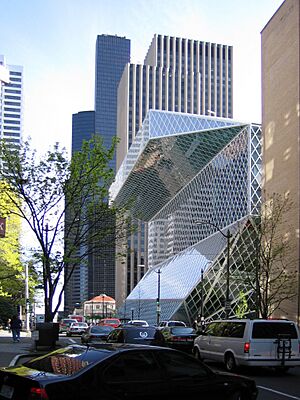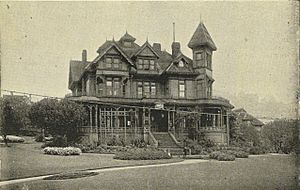Seattle Public Library facts for kids
Quick facts for kids Seattle Public Library |
|
|---|---|
 |
|
| Seattle Central Library in 2019 | |
| Type | Public library |
| Established | 1890 |
| Location | Seattle, Washington, U.S. |
| Coordinates | 47°36′25″N 122°19′58″W / 47.60694°N 122.33278°W |
| Branches | 27 |
| Collection | |
| Size | 2.8 million (2023) |
| Access and use | |
| Circulation | 13.4 million (2023) |
| Members | 293,000 active patrons (2023) |
| Other information | |
| Budget | $93.9 million (2023) |
| Director | Tom Fay (Executive Director and Chief Librarian since 2022) |
| Staff | 675 (part- and full-time) as of 2023 |
| References: The Seattle Public Library's 2023 Statistical & Financial Summaries | |
The Seattle Public Library (SPL) is the main library system for the city of Seattle, Washington. People started trying to create a library in Seattle as early as 1868. The city officially opened the library system in 1890.
Today, the Seattle Public Library has 27 locations. Most of these are named after the neighborhoods they serve. The system also includes Mobile Services and the amazing Seattle Central Library. This main library was designed by famous architect Rem Koolhaas and opened in 2004. The Seattle Public Library also started the Washington Talking Book & Braille Library (WTBBL), which helps people who are blind or have trouble reading regular books.
Many of Seattle's first libraries were Carnegie libraries, built with money from businessman Andrew Carnegie. While the main Carnegie library has been replaced twice, many of the early branch libraries from the 1900s are still standing. Some, like the Fremont and Green Lake branches, have been updated and are still used as libraries today.
In 2023, the library served nearly 300,000 active users. Over 124,000 people borrowed physical books and other items, and 175,000 borrowed digital materials. The library also hosted 3,500 classes and events, and people used its public computers over 340,000 times.
Contents
Library Locations: Where to Find Books
The Seattle Public Library system has 27 different locations. This includes the large Seattle Central Library and a special mobile library that travels to different places.
- Ballard
- Beacon Hill
- Broadview
- Capitol Hill
- Columbia (in Columbia City)
- Delridge
- Douglass–Truth (named after Frederick Douglass and Sojourner Truth)
- Fremont
- Green Lake
- Greenwood
- High Point
- International District/Chinatown
- Lake City
- Madrona–Sally Goldmark
- Magnolia
- Montlake
- North East (in View Ridge)
- Northgate
- NewHolly
- Queen Anne
- Rainier Beach
- Southwest (in Westwood)
- South Park
- University (in the University District)
- Wallingford
- West Seattle
What You Can Find and Do at the Library
The Seattle Public Library has a huge collection of items. In 2023, it had 1.8 million physical items. This includes books, CDs, DVDs, and audiobooks. They also have cool things like laptops, tablets, Wi-Fi hotspots, and even devices to measure electricity use!
The library also has special collections. These include stories from people's lives (oral histories), records about Seattle's past, and a collection of zines. Zines are small, self-published magazines. You can even find books at some locations that you can borrow without a library card.
Online Resources and Digital Fun
The library offers many online resources too. You can read old newspapers like The Seattle Times and The New York Times. You can also access Britannica Library for research, Kanopy for streaming videos, and ProQuest for academic articles. Plus, there are tons of e-books and e-audiobooks available. In 2023, people borrowed 7.4 million digital items!
Through a program called Books Unbanned, young people aged 13 to 21 across the United States can access these online resources for free. The library also offers free passes to 13 local museums, zoos, and other fun places. You can reserve these passes online.
A Look Back: The Library's History
Starting the Library: The Early Years (Late 1800s)
The idea for a public library in Seattle began in 1868. However, it wasn't until 1888 that a group called the Ladies' Library Association really pushed for it. They raised money and even got a promise of land. But then, the Great Seattle Fire of 1889 destroyed much of the city.
Despite the fire, the city decided to create the Public Library as part of the government in 1890. The Ladies' Library Association had a big impact, as the city rules said at least two of the five library leaders had to be women. The library got its funding from city fines and licenses.
The first library opened on April 8, 1891, as a reading room. By December 1891, it had over 6,500 books that people could borrow. In its early years, the library moved several times to different buildings as it grew. In 1898, it moved to the former Yesler Mansion.
Growing Bigger: The Carnegie Era (Early 1900s)
On January 1, 1901, the Yesler Mansion burned down, destroying most of the library's books. Luckily, the children's books and library records were saved. Just a few days later, Andrew Carnegie, a very rich businessman, promised $200,000 to build a new library.
The new Carnegie library opened on December 19, 1906. It was a big step for the library system. Soon after, the library started adding more specialized departments, like art and technology.
Carnegie also helped build many branch libraries. He donated money for branches in the University District, Green Lake, West Seattle, Queen Anne, and Columbia City. The Fremont branch, which opened in 1921, was the last of this big expansion era. It would be over 30 years before another new branch was built.
By 1915, the library had books in many different languages, not just English. It also had one of the few collections for blind people in the western United States.
Tough Times and New Growth (Mid-1900s)
During the Great Depression in the 1930s, the library faced big challenges. Many people lost their jobs, and the library became a refuge for them. More people borrowed books than ever before, but the library's budget was cut, and staff were laid off.
After World War II, things started to get better. In 1949, the Central Library added more space for books. Three new, modern branch libraries were built in 1954. The library also had "book stations" in places without a full branch, and a bookmobile that brought books to different neighborhoods.
A Modern Library for a Modern City (The 1960s)
In 1956, Seattle voters approved money to build a new, modern Central Library. This new building opened on March 26, 1960. It was very modern for its time, with the first escalator in an American library and a drive-up window for picking up books. It also featured new works of art.
The new library was a huge success! It loaned out almost 1 million books in its first nine months. The 1956 funding also helped build new branches in Southwest, Ballard, and Magnolia.
Challenges and Comebacks (Late 1900s)
The 1970s and 1980s brought tighter budgets for the library. However, it still made important improvements. In 1975, the Yesler Branch was renamed the Douglass-Truth Branch, honoring Frederick Douglass and Sojourner Truth. This branch has a large collection of African American books and materials.
Federal grants helped update the Central Library in 1979 and build the Rainier Beach Branch in 1981. In the late 1980s, the library restored its six historic Carnegie branches.
To help get more money, The Seattle Public Library Foundation was started in 1980. By the mid-1990s, donations were over $1 million each year.
Libraries for All: A New Era (1998-Present)
In 1998, Seattle voters approved a huge plan called "Libraries for All." This plan provided $196 million, plus private donations, to build new branches and a brand new Central Library. This nearly doubled the space in Seattle's libraries.
The library also started using an RFID system for materials. This lets people check out books themselves, so librarians can spend more time helping with questions.
From 1993 to 2004, the library was home to Nancy Pearl, a famous librarian. She created the "If All Seattle Read the Same Book" project, which encouraged everyone in the city to read and discuss the same book.
After some budget cuts between 2009 and 2012, Seattle voters approved a new tax in 2012 to bring back services. This allowed more branches to be open on Sundays and seven days a week. It also provided money for new books and computers.
In 2019, voters approved another $219 million to fund library services. This included longer hours, building repairs, and social services. It also meant the library stopped charging overdue fines starting in January 2020, making it easier for everyone to use the library.
During the COVID-19 pandemic in March 2020, the library closed its branches. Some reopened for curbside pickup, and five branches opened to provide public bathrooms for people experiencing homelessness. Most branches fully reopened by October 2021.
In May 2024, the library's online services were shut down by a ransomware attack. Most online services were restored by August 2025. The attack affected information from nearly 27,000 library users and employees.
Cool Buildings: Library Architecture
Many of The Seattle Public Library's buildings are famous for their design. They show off different styles from different times. The old Carnegie libraries and the Douglass-Truth library are from the early 1900s.
The Seattle Central Library, which opened in 2004, is a very famous building. It was designed by Rem Koolhaas and Joshua Prince-Ramus. In 2007, it was voted one of Americans' favorite structures by the American Institute of Architects.
Six current Seattle branch libraries are listed on the National Register of Historic Places. These include the Columbia, Fremont, Green Lake, Queen Anne, University, and West Seattle branches.
The new Ballard Branch is also special because it uses "green architecture." It has solar panels to save electricity and a green roof. The green roof helps insulate the building and reduces rainwater runoff.
Images for kids
See also
 In Spanish: Biblioteca Pública de Seattle para niños
In Spanish: Biblioteca Pública de Seattle para niños















